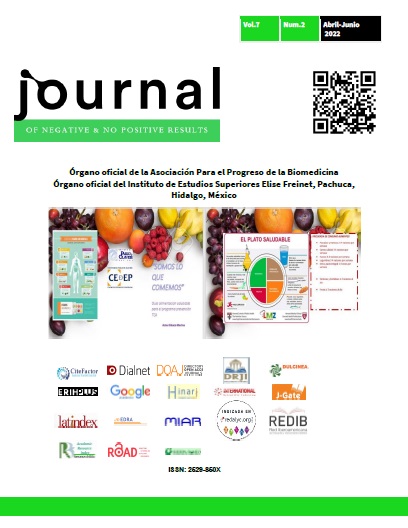Prevention of diabetic foot amputations
DOI:
https://doi.org/10.19230/jonnpr.4450Keywords:
Diabetic foot; Mellitus diabetes; Ulcers; PreventionAbstract
Diabetic foot disease is a complication of diabetes mellitus that is increasing drastically due to the increasing number of people with diabetes in the western world and the increased life expectancy of these people. This condition mainly involves appearance of foot ulcers, which, if not treated properly and early, can lead to ultimately lead to amputation of the lower extremity. Therefore, it is a serious complication, which causes disability, a great affectation to the quality of life of the patient and considerable economic costs for the health system. Consequently, it is of vital interest gather evidence-based preventive strategies to mitigate the consequences of this serious complication, focusing not only on the proper treatment of the ulcer, but, above all, on treating the causes of this, in order to prevent recurrent ulcers and the appearance of new ulcers in patients at risk.
Downloads
References
Adiewere P, Gillis RB, Jiwani SI, Meal A, Shaw I, Adams GG. A systematic review and meta-analysis of patient education in preventing and reducing the incidence or recurrence of adult diabetes foot ulcers (DFU). Heliyon 2018;4(5):e00614.
Alavi A, Sibbald RG, Mayer D, et al. Diabetic foot ulcers Part I. Pathophysiology and prevention. J Am Acad Dermatol 2014;70(1):1.e1.
Sabapathy SR, Periasamy M. Healing ulcers and preventing their recurrences in the diabetic foot. Indian J Plast Surg 2016;49(3):302–13.
Margolis DJ, Hoffstad O, Weibe DJ. Lower-Extremity Amputation Risk Is Associated With Variation in Behavioral Risk Factor Surveillance System Responses. Diabetes Care 2014;37(8):2296–301.
Bharara M, Schoess J, Armstrong DG. Coming events cast their shadows before: detecting inflammation in the acute diabetic foot and the foot in remission. Diabetes-Metab Res Rev 2012;28:15–20.
Wendling S, Beadle V. The relationship between self-efficacy and diabetic foot self-care. J Clin Transl Endocrinol 2015;2(1):37–41.
Alvarsson A, Sandgren B, Wendel C, Alvarsson M, Brismar K. A retrospective analysis of amputation rates in diabetic patients: can lower extremity amputations be further prevented? Cardiovasc Diabetol 2012;11:18.
Kim PJ, Attinger CE, Evans KK, Steinberg JS. Role of the podiatrist in diabetic limb salvage. J Vasc Surg 2012;56(4):1168–72.
Schirmer S, Ritter R-G, Fansa H. Vascular Surgery, Microsurgery and Supramicrosurgery for Treatment of Chronic Diabetic Foot Ulcers to Prevent Amputations. Plos One 2013;8(9):e74704.
Fujiwara Y, Kishida K, Terao M, et al. Beneficial effects of foot care nursing for people with diabetes mellitus: an uncontrolled before and after intervention study. J Adv Nurs 2011;67(9):1952–62.
Schaper NC, van Netten JJ, Apelqvist J, Bus SA, Hinchliffe RJ, Lipsky BA. Practical Guidelines on the prevention and management of diabetic foot disease (IWGDF 2019 update). Diabetes-Metab Res Rev 2020;36.
Lim JZM, Ng NSL, Thomas C. Prevention and treatment of diabetic foot ulcers. J R Soc Med 2017;110(3):104–9.
Armstrong DG, Andros G. Use of negative pressure wound therapy to help facilitate limb preservation. Int Wound J 2012;9:1–7.
Bus SA, Lavery LA, Monteiro-Soares M, et al. Guidelines on the prevention of foot ulcers in persons with diabetes (IWGDF 2019 update). Diabetes-Metab Res Rev 2020;36:e3269.
Dorresteijn JAN, Kriegsman DMW, Assendelft WJJ, Valk GD. Patient education for preventing diabetic foot ulceration. Cochrane Database Syst Rev 2012;(10):CD001488.
Cavanagh PR, Bus SA. Off-loading the diabetic foot for ulcer prevention and healing. J Vasc Surg 2010;52:37S-43S.
Elraiyah T, Prutsky G, Domecq JP, et al. A systematic review and meta-analysis of off-loading methods for diabetic foot ulcers. J Vasc Surg 2016;63(2):59S-U87.
Hasan R, Firwana B, Elraiyah T, et al. A systematic review and meta-analysis of glycemic control for the prevention of diabetic foot syndrome. J Vasc Surg 2016;63(2):22S-U89.
Ozdemir BA, Brownrigg J, Patel N, Jones KG, Thompson MM, Hinchliffe RJ. Population-based screening for the prevention of lower extremity complications in diabetes. Diabetes-Metab Res Rev 2013;29(3):173–82.
Lowe JR, Raugi GJ, Reiber GE, Whitney JD. Does Incorporation of a Clinical Support Template in the Electronic Medical Record Improve Capture of Wound Care Data in a Cohort of Veterans With Diabetic Foot Ulcers? J Wound Ostomy Continence Nurs 2013;40(2):157–62.
Published
Issue
Section
License
All accepted originals remain the property of JONNPR. In the event of publication, the authors exclusively transfer their rights of reproduction, distribution, translation and public communication (by any sound, audiovisual or electronic medium or format) of their work. To do so, the authors shall sign a letter transferring these rights when sending the paper via the online manuscript management system.
The articles published in the journal are freely used under the terms of the Creative Commons BY NC SA license, therefore.
You are free to:
Share — copy and redistribute the material in any medium or format
Adapt — remix, transform, and build upon the material
The licensor cannot revoke these freedoms as long as you follow the license terms.
Under the following terms:
Attribution — You must give appropriate credit, provide a link to the license, and indicate if changes were made. You may do so in any reasonable manner, but not in any way that suggests the licensor endorses you or your use.
NonCommercial — You may not use the material for commercial purposes.
ShareAlike — If you remix, transform, or build upon the material, you must distribute your contributions under the same license as the original.
No additional restrictions — You may not apply legal terms or technological measures that legally restrict others from doing anything the license permits.

This work is licensed under a Creative Commons Attribution-NonCommercial-ShareAlike 4.0 International License

























